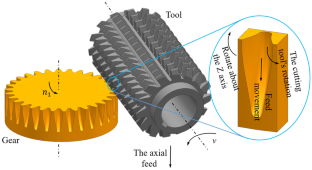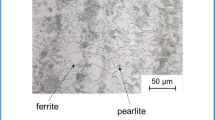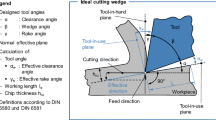Abstract
Gear has been widely applied in the automotive and aerospace manufacturing industries. The machining process is complicated, and the material is difficult to cut. High-speed dry gear hobbing has higher cutting efficiency, but there are some problems in the cutting process, such as larger cutting force and higher cutting temperature, which lead to serious tool wear. Therefore, the wear mechanism of high-speed dry gear hobbing is attracting increasing research attention. Firstly, based on the multi-edge intermittent cutting theory of high-speed dry gear hobbing, the undeformed geometry chip is determined to provide theoretical support for predicting cutting force and tool wear. Secondly, the finite element simulation analysis of high-speed dry gear hobbing is carried out to discuss the chip deformation, tool temperature distribution characteristics, cutting force, tool wear state, and the change law of wear variation in the different cutting parameters. Finally, the wear experiment of high-speed dry hob is performed. The wear trend of the rake face and flank face is discussed, and the wear morphology and mechanism of the tool under different cutting parameters are analyzed. The simulation results are compared with the experimental results, and the simulation results of tool wear forms and wear trends are in good agreement with the experimental results. These findings may provide an effective basis for exploring the wear mechanism of the tool, improving tool life, and providing technical support for the design and development of machining tools for gear.














































Similar content being viewed by others
Availability of data and materials
The data that support the results of this article are included within the article.
References
Li CB, Fu S, Chen XZ, Ji QQ (2020) Multi-objective CNC gear hobbing parameters optimization model for high efficiency and energy saving. Comput Integr Manuf Syst 26(3):676–687
Zhao H, Wu QL, Huang K, Qiu MM, Liu P (2013) Status and problem research on gear study. J Mech Eng 49(19):11–20
Stark S, Beutner M, Lorenz F, Uhlmann S, Karpuschewski B, Halle T (2013) Heat flux and temperature distribution in gear hobbing operations. Procedia CIRP 8(1):456–461
Zhang RC, Li BC, Zhang JQ (2019) Prediction of cutting forces in gear hobbing of cylindrical gears. J Northeast Univ Nat Sci 40(7):980–985
Sari D, Troß N, Löpenhaus C, Bergs T (2019) Development of an application-oriented tool life equation for dry gear finish hobbing. Wear 426:1563–1572
Karpuschewski B, Beutner M, Köchig M, Wengler M (2017) Cemented carbide tools in high-speed gear hobbing applications. CIRP Ann Manuf Technol 66(1):117–120
Orestis F, George M (2011) An investigation of cutting edge failure due to chip crush in carbide dry hobbing using the finite element method. Int J Adv Manuf Technol 57(1–4):297–306
Akio K, Hua Q, Hironori M (2015) Cutting performance of coated high-speed steel hobs in dry hobbing. Adv Mater Res 1077:56–60
Lin O (2020) Simulation and application of gear hobbing process based on VERICUT. Auto Manuf Eng 3:14–16
Kühn F, Lpenhaus C, Brimmers J, Klocke F, Bergs T (2020) Analysis of the influence of the effective angles on the tool wear in gear hobbing. Int J Adv Manuf Technol 108(2):2621–2632
Yang X, Cao H, Du Y (2018) Regulation and control method for tool temperature in high-speed dry cutting process based on specific cutting energy. Chin Mech Eng 29(21):2559–2564
Xu SN, Shen HY (2016) Research on thermal-force coupling and processing parameter of high-speed dry hobbing. Mech Electr Eng 33(7):836–842
Bouzakis K, Friderikos O, Tsiafis I (2008) FEM-supported simulation of chip formation and flow in gear hobbing of spur and helical gears. CIRP J Manuf Sci Technol 1(1):18–26
Bernhard K, Martin B, Max K, Christian H (2016) Influence of the tool profile on the wear behavior in gear hobbing. CIRP J Manuf Sci Technol 18:128–134
Vasilis D, Nectarios V, Aristomenis A (2007) Advanced computer aided design simulation of gear hobbing by means of three-dimensional kinematics modeling. J Manuf Sci Eng 129(5):911–918
Liu W, Ren D, Usui S, Wadell J, Marusich T (2013) A gear cutting predictive model using the finite element method. Procedia CIRP 8(1):51–56
Kadashevich I, Beutner M, Karpuschewski B, Halle T (2015) A novel simulation approach to determine thermally induced geometric deviations in dry gear hobbing. Procedia CIRP 31:483–488
Claudin C, Rech J (2009) Development of a new rapid characterization method of hob’s wear resistance in gear manufacturing-application to the evaluation of various cutting edge preparations in high-speed dry gear hobbing. J Mater Process Technol 209(11):5152–5160
Dimitriou V, Antoniadis A (2009) CAD-based simulation of the hobbing process for the manufacturing of spur and helical gears. Int J Adv Manuf Technol 41(3–4):347–357
Naoual S, Abdelhadi M, Mohammed N, Armansyah G (2020) A thermomechanical modeling and experimental validation of the gear finish hobbing process. Int J Precis Eng Manuf 21(3):347–362
Chen YP, Cao HJ, Li XG, Chen P (2016) The model of spatial forming with multi-cutting-edge for cylindrical gear hobbing and its application. J Mech Eng 52(9):176–183
Funding
This work was financially supported by Yancheng Hali Power Transmission and Intelligent Equipment Industry Research Institute Project and National Natural Science Foundation of China (Grant no. 51675145).
Author information
Authors and Affiliations
Contributions
Research conception and design: Yaonan Cheng. Drafting of manuscript: Chunjie Ma. FE simulation analysis: Chunjie Ma, Jianyu Zhang. Acquisition of data: Huan Zhou, Xinyu Wang. Data analysis and model building: Liming Xin.
Corresponding author
Ethics declarations
Ethics approval
Not applicable.
Consent to participate
The authors have consent to participate.
Consent to publish
The authors have consent to publish.
Competing interests
The authors declare no competing interests.
Additional information
Publisher's Note
Springer Nature remains neutral with regard to jurisdictional claims in published maps and institutional affiliations.
Rights and permissions
About this article
Cite this article
Cheng, Y., Ma, C., Zhang, J. et al. Simulation and experimental study of tool wear in high-speed dry gear hobbing. Int J Adv Manuf Technol 119, 3181–3204 (2022). https://doi.org/10.1007/s00170-021-08421-4
Received:
Accepted:
Published:
Issue Date:
DOI: https://doi.org/10.1007/s00170-021-08421-4




